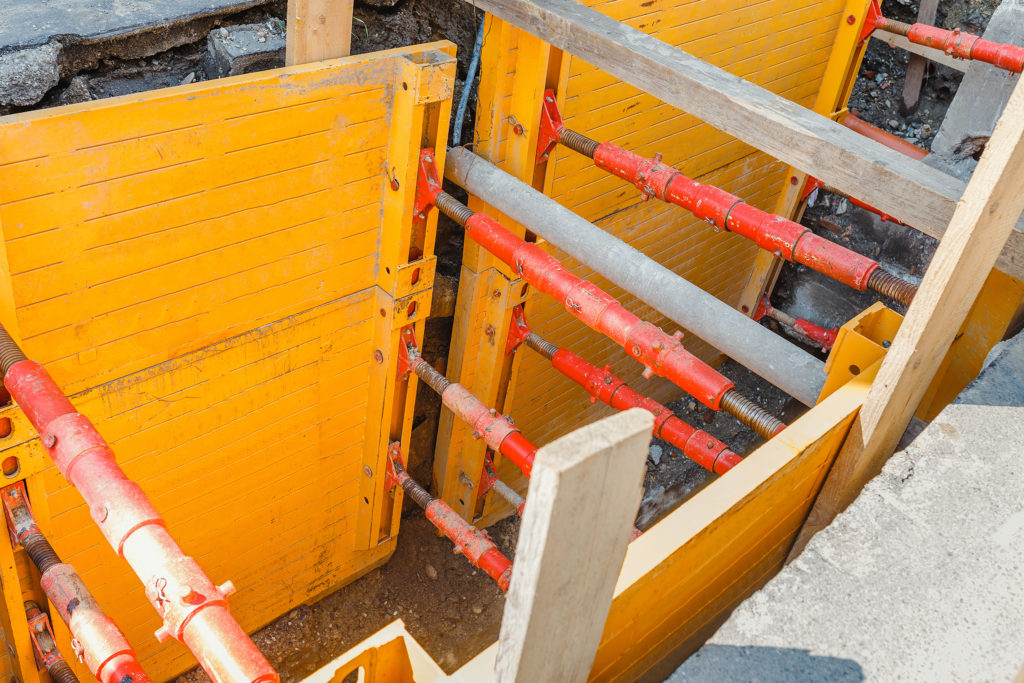Safety is one of the most important aspects when it comes to choosing your construction equipment. When it comes to trench digging and underground projects, the risk of cave-ins is both very high and very dangerous. When compacted land is disturbed, e.g. through the process of trench digging, it becomes susceptible to unexpected crumbling and caving, risking the lives of workers and the equipment within the trench. In order to prevent this risk factor, hydraulic shores were invented.
What Is Hydraulic Shoring?
Hydraulic shores are similar to aluminum trench shields, and are formed from steel cylinders and planks used to form a ladder shape. Generally these structures have either two or three perpendicular beams that run across the center of the two side pieces. They are installed from the surface and placed on either side of the trench. They remain in position until the project is completed and are removed from above. They are both easily and safely placed and moved.
How Do Hydraulic Shores Work?
Hydraulic shores function through applying pressure to both sides of trench walls, to prevent the loose soil, gravel, or other material from caving in on the construction workers. Hydraulic shores are often used in projects that surround existing utility lines or to support walls that are near curbs, structures, or sidewalks. For much larger jobs, generally a backhoe is used. But, in smaller jobs, hydraulic shores are the best option.

Different Types of Hydraulic Shores
Depending on the project and purpose, there are different types of hydraulic shoring to choose from.
- Vertical Shores. Vertical shores are built to prevent cave-ins from happening. They support the side of trench walls using hydraulic pressure. They are safe, useful, and simple to use. Vertical shores are made to be installed and removed completely from the top of the trench. They are often used in production trenching or for spot bracing in repair situations.
- End Shores. End shores differ from traditional shores in that they are used at either end of a trench as opposed to the side barriers. They are built to close off the end of an excavation. Oftentimes, they are used together with other types of shoring for maximum safety. Shores that are built from the same manufacturer are meant to be used together.
- Hydraulic Shields. Hydraulic shields are a type of trench shields that are made up of lightweight, aluminum walls that are paired with sturdy hydraulic struts. The strut of the hydraulic shield is built from a hydraulic cylinder and a return spring, encased by steel box tubing. Because of their composition, they are easily transported, assembled, and handled by rubber-tired backhoes. These are often used in municipal projects, utility work, cable jobs, and other moderate-duty underground construction.
- Waler Systems. Waler systems offer the most protection of all the hydraulic shoring options. Their versatility and flexibility makes them a common choice for projects that involve crossing utility lines. There are two styles of waler systems. One option has hydraulic struts that allow end-loading in three or four sided applications. These typically include pipe repair or valve maintenance. Walers made with hydraulic cylinders are made to be used in 2-sided applications and are often used in production works. Waler systems, when used with proper sheeting, can be versatile and offer increased shoring protection.
- Manhole Shores. Manhole shores are often used for projects surrounding their namesake, manholes. Because of their shape, they are often used in rectangular or square excavations. They are made to provide 4-way hydraulic support by pushing against the trench walls to form an obstruction. An obstruction is defined as a free pit that allows for enough working room to install manholes or vaults, or operate equipment in the small space. Manhole shores are transported in four individual pieces and tube sections and are assembled on site.
How Do You Install a Shore?
The installation of a shore can depend on what kind of shore you’re using and the project’s limitations. However, generally most shores follow the same sort of method. The first step is to position the shore at the edge of the trench you’re working with and connect the hose line to the fitting. The next step is to drop the shore into the trench at the height you want. Lastly, pump to a minimum pressure of 750 psi. When it reaches the right pressure, disconnect the hose from the fitting using a release tool.
How Do You Remove a Shore?
Similar to installing a shore, how you remove the shore will depend on the type of shore you use and the job site you’re working in. Most often, the first step in removing a shore involves releasing the hydraulic shoring fluid at a fitting using a release tool. Then, pull the shore structure out from the trench using the release and the removal hook. From there, the shore should fold into a flat shape for easy transportation to the next job site.
Rasmussen Equipment
Rasmussen Equipment has been serving the Utah region since 1947. Today it is one of the largest rigging houses in the intermountain West, servicing states all across the western half of the United States. With a variety of construction equipment available, we are here to help with renting heavy machinery and other tools, custom wire rope, chain, nylon, and other rope assemblies. All our shoring equipment is provided by GME and is trusted and certified.

